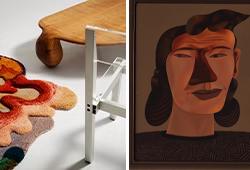Eric Grate
"Amasonpistill"
Executed 1931/32. Bronze with light brown patina, height 95 cm including the stone base.
Provenance
The artist, thence by descent to present owner.
Exhibitions
Artists' House, Oslo, "Eric Grate", 7 - 29 March 1960, catalogue no. 225, cat. no. 23.
Swedish-French Art Gallery, Stockholm, "Eric Grate", March 1954, catalogue no. 259, cat. no. 48.
Lund Art Hall, "Eric Grate - Painting and Sculpture", 27 August - 18 September 1960, cat. no. 24.
Norrköping Museum, "Eric Grate's Metamorphoses", 24 September - 19 October 1960, cat. no. 21.
National Museum of Modern Art, Paris, "Eric Grate - Swedish Sculptor", 22 March - 15 April 1963, cat. no. 25.
Royal Academy of Fine Arts, "Eric Grate Sculptures", March 1965, cat. no. 20.
Literature
Exhibition catalogue, Kunstnerernes Hus, Oslo, "Eric Grate", 7 - 29 March 1960, catalogue no. 225, cat. no. 23, illustrated full page p. 17.
Exhibition catalogue, Lunds konsthall, "Eric Grate - Painting and Sculpture", 27 August - 18 September 1960, cat. no. 24, illustrated full page p. 8.
Exhibition catalogue, Norrköping Museum, "Eric Grate's Metamorphoses", 24 September - 19 October 1960, cat. no. 21, illustrated p. 6.
Ragnar von Holten, “Surrealism in Swedish Art”, SAK, 1969, illustrated p. 193.
Pontus Grate and Ragnar von Holten, Eric Grate, SAK, 1978, illustrated p. 45.
More information
"At the Green Lund of the past in Paris, Luna Park, in the late 1920s, the main attraction was an Austrian-born woman without arms and legs who was exhibited under the name Miss Violetta (fig 1.), displayed on a tray atop a pedestal and dressed in a bag-like light green casing. In her own way, she was so beautiful and alluring that she was repeatedly abducted by young gentlemen, more or less willingly, it seems, and certainly in collusion with her female accomplices. Among the spectators were a number of surrealist writers and artists - including Eric Grate. The poet Gunnar Ekelöf, who later heard about her, writes that she fascinated them because she was like "a beautiful French pear, as self-evident and natural armless and legless as any pear can be. She was a kind of living object..."
Eric Grate, for his part, viewed the whole thing from a broader perspective, weaving together elements from the primary sources of inspiration for his entire artistic career: nature, antiquity, and primitive cultures. Thus, he associated not only with the common abductions of women in antiquity (the Sabine women, Europa and the bull...) but also with similar occurrences that constantly unfold in the entomological realm; the insect world that he had loved to study and draw since childhood, alongside the plant world. In the multi-layered, ambiguous Entomological Abduction of Women that he conceived in 1928, he allows us to witness how in the relief's narrow stage a clearly feminine figure is abducted by two peculiar figures. One, who is fussily pointing the way, is coquettishly dressed in a skirt with ruffles while her head resembles the larvae of ants. Her companion, who virilely grabs the victim with antennae and suction pads, has features of a grasshopper larva. The abducted one herself is endowed with the body of an insect pupa and a head inspired by the stigma of flowers in its lobes. She is one-breasted like the Amazons of antiquity, and her flowing hair may also evoke the plume of these proud warrior women. These traits become even more pronounced in the sculpture from 1932 that Grate named Amazon Stigma, where the abducted woman appears in solitary majesty (fig 2.). Moreover, it is not without resemblance to certain primitive tribes' fertility idols.
Pontus Grate
"The Entomological Abduction of Women" fig 3, where "Amazon Stigma" is one of the figures, was executed between 1956 and 1958 and can be viewed on a four-meter-high granite pillar immediately outside the entrance to the Karolinska Institute in Stockholm, fig 4."
Artist
Eric Grates idiosyncratic world of images always invites exploration and wandering within the imagination. While he respects the the earths natural forms, he sometimes "plays with god", manipulating and playing with nature to create new surprising objects which we recognise but simultaneously dont recall. He borrows fragments from nature and uses his endless imagination to create art in his unique way. His visual language emualtes an aura of abstract surrealism derived from "object trouvés". Grate was inspired by natures radiance and its different forms. Stones, roots, insects, bones, all were transformed into sculptures, particularly the insect world was a source of great inspiration for Grates. During the 1960s, beach, hull, and bones were particularly the starting points for his sculptures. He created numerous official artworks.
Grate began his academic trips after finishing his studies at Royal Swedish Academy of Fine Arts from 1979-20, where he travelled to Italy and Greece, filling his sketchbooks with studies of insects, plants, unique architecture, sculpture, and ceramics. He spent a longer period between 1924 and 1933 in Paris, a formative period where he was one of the few Swedish artists who was associated with the avante garde; we got in contact with none other than the surrealists Jean Arp, Paul Eluard, and Tristan Tzara. Grate is seen by many as one of Sweden's most influential sculptors during the 1900s.
Read more






























































